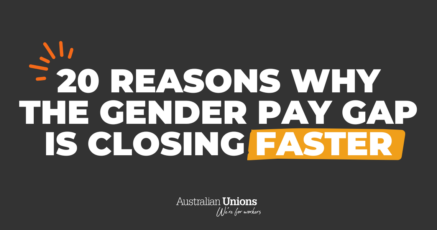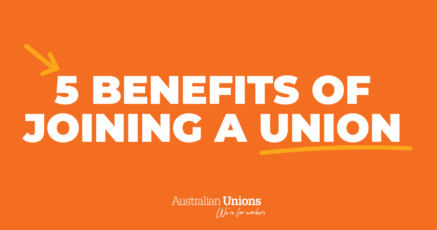This year, workers across the country used their collective power to make unprecedented strides in the quest for a safer and more just world for women – at work and at home.
We entered 2022 under the leadership of a Morrison Government that valued CEO pay packets over women’s lives, put LGBTQIA+ people’s lives at risk through discriminatory bills and was missing in action at key moments when we needed them to show up.
That’s why union members put women’s rights front and centre in 2022, pushing for systemic change that entitles everyone to a safe and secure working life.
A big part of this was campaigning to elect a government that cares about working people and gender equality – and we are glad to be seeing the year out with just that.
It’s not just women who benefit from gender equality – the whole of society is better off when everyone is cared for. The national gender pay gap nears $1 billion per week and remains one of the biggest contributors to inequality in this country.
Evidence shows that closing the gender pay gap comes with both economic and social advantages – like more money in family budgets, and improved wellbeing for women and those that they care for.
Looking at the success of union-backed campaigns this year, it’s no wonder that women now make up 54 per cent of our movement.
So what does it look like to be a working woman in 2022?
Women’s safety
As we enter the new year, women living in fear of violence and abuse will soon have access to ten days paid domestic and family violence leave.
This means they can take the time they need to leave without being forced to return to a violent situation due to lack of support. Ten days of paid leave provides means to organise housing, counseling and schooling for kids. This is hugely meaningful for the 2.2 million Australians who have experienced physical and/or sexual assault from a partner, and the 3.6 million Australians who have experienced emotional abuse from a partner.
In the workplace, the recently-passed Respect@Work Bill places positive duty on employers to protect employees from sexual assault and harassment at work. Given that 1 in 2 women report leaving their jobs after experiencing harassment at work, the new protections will help keep women at work without fear for their safety.
In swift succession to this long overdue policy move, the Government has also moved to ratify the International Labour Organisation’s (ILO) Violence and Harassment Convention, 2019 (109) – which recognises every worker’s fundamental right to be free from all forms of violence and harassment at work.
Progress on equal pay
Union members have fought hard to ensure governments address wage inequality in ‘feminised’ industries this year, with history-making strikes in childcare, healthcare and teaching.
A major win saw a 15 per cent pay increase passed onto aged care workers just last month.
The interim pay increase is significant in many ways. It will immediately improve the lives of care workers – and by association the quality of care that older Australians receive – but above all, it sends a message: women’s work matters. The decision is an important first step to achieve an essential 20 per cent wage increase for all aged care workers.
Achieving pay equity in these historically undervalued and underpaid industries means that money is put back into the pockets of burnt out workers and those who are caring for our loved ones earn enough to stay in their jobs.
Recognition for these workers was felt on a global level too – in June, workers around the world won a new fundamental right to a healthy and safe workplace. Recognised at this year’s International Labour Conference in Geneva, this new right is particularly important for those who work in care industries, as these workers are more vulnerable to sickness and abuse.
More recently, the new work laws from the Secure Jobs, Better Pay Bill address a broken industrial relations system by opening up multi-employer bargaining. This is significant, as workers on collective agreements earn $312 more per week on average, than those who are not, and workplaces with collective agreements in place have lower gender pay gaps than those without.
While these achievements have a direct impact on the lives of working people, these changes also de-stigmatise issues faced by women. They also help create more inclusive, safer and caring workplaces, and hold employers accountable for employee safety and wage equality.
The challenges ahead
Despite the incredible leaps that we have made, working women still face a number of challenges, and people of colour, those living with disability, those from diverse cultural and linguistic backgrounds, migrants, and LGBTQI+ people are extra vulnerable to these challenges.
Women still earn less than men, and retire with less than men.
Feminised work continues to be undervalued, and women still carry the burden of caring duties and the ‘mental load’ that leads to fatigue and burn out.
New-world ways of remote and multi-platform work has brought with it an increased inability to disconnect from work, precariousness from a growing, insecure gig economy, and women struggling with social media pressure to participate in ‘hustle culture’.
Union members are keeping up the campaigns for reproductive leave, better parental leave, and free childcare to help them stay and thrive in the labour market.
What about 2023?
2023 poses its own set of challenges – Australian families are reckoning with a cost of living crisis caused by rising interest rates, hiked grocery bills, and extortionate electricity bills as a result of inflation. Unions are fighting for real wage growth to help combat the insecurity that will come with this difficulty.
If there’s one thing we can take away from 2022, it’s that collective action changes lives.
Joining your union is the best way to ensure that we meet 2023 with the strongest backing and the loudest voice.
What workers can be sure of is that unions will always be in your corner, into next year and beyond.







SHARE:
An awe-inspiring 2022 for working women